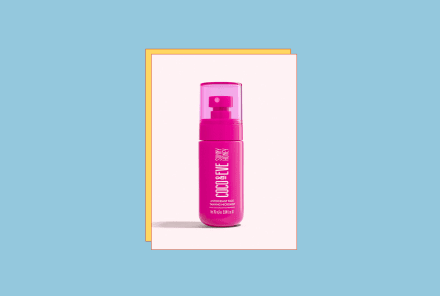Advertisement
These 5 Appliances Are Hotspots For Mold: How To Keep Them Clean


Appliances are a key part of any household but unfortunately, they're also hot spots for mold. Taking a few simple steps to prevent microbial growth in your appliances can help you enjoy their benefits without any unhealthy exposures. Because no one wants to drink coffee with a hint of mold or breathe in air that’s packed full of microscopic particles.
Why are appliances common areas for mold growth?
When a mold colony develops, it reproduces by releasing microscopic particles called spores into the surrounding area. Think of them like the fluffy white seeds of a dandelion. Thanks to their small size, these spores can zip all over the place, including in our homes.
Like seeds, mold spores are non-living particles and will remain unalive until they land on a surface with the right components for growth. Most species of mold only need two key elements to begin growing: food and moisture. A key detail to remember is that if these two things are present for 24–48 hours, some species of mold can begin to grow. That’s why time is of the essence when it comes to mold prevention.
Appliances are one of the top places for microbial growth because they often contain the components needed for a spore to transition into a living colony. Take a laundry machine, for example. Its soap scum, organic matter from clothing, and mineral buildup offer excellent sources of food. The majority of appliances also collect moisture. The rubber gaskets and small crevices in appliances like coffee makers, for instance, can trap moisture during and after use. To make matters more toxic, bacteria grow in similar conditions to mold and can often be found growing right alongside colonies. Essentially, these machines can quickly become a microbial growth haven.
Once this happens, every time you turn the machine on, you’re blasting all sorts of particles onto clothes, food, and beverage items, as well as throughout your home. That is not a recipe for making your body happy.
The importance of avoiding mold in appliances
Once the mold spore transitions into the world of the living, it will start growing roots called hyphae into the surface it landed on. A reproductive cycle will start up as well, releasing spores into the surrounding area. Some species of mold also release microscopic toxins called mycotoxins, which are harmful to the human body.
Your body will tag these particles as foreign invaders and send the immune system to get rid of them. However, high volumes of exposure can lead to the immune system malfunctioning or becoming overwhelmed, leading to a long list of potential chronic symptoms. These symptoms can persist as long as the exposure continues.
The issue is that these microscopic particles are small enough to be inhaled, ingested, and absorbed into the body. Just because you can’t see them doesn’t mean that they’re not causing harm to your health. Mold in a refrigerator's water spout is an example: Not only is it lowering your indoor air quality, but it’s also filling your water with all sorts of particles that then make their way into your body every time you take a sip.
How to prevent microbial growth in your appliances
The key way to prevent microbial growth in appliances is to keep them as clean and dry as possible. This eliminates the components needed for growth, preventing organisms like mold and bacteria from moving in. It also helps reduce microscopic particles like spores, which may have blown into the home and landed on the appliance. The faster these particles are removed, the less likely they will develop into living colonies.
From there, focus on ensuring your appliances are operating properly and don’t have wear and tear. Maintenance issues can lead to excess or trapped moisture, allowing for contaminants to move in.
Here are a few ways to prevent mold on common appliances, but always check the manufacturer’s instructions for recommendations on your specific machine:
Laundry machine:
- Leave the lid and the detergent tray open when not using the machine to reduce moisture trapped within the machine and allow for airflow.
- Wipe down the seals after washing to remove pooled moisture.
- Use the right detergent. If it calls for high-efficiency products, that’s what you should go with. Too many suds can leave the door wide open for mold growth.
- Use a botanical laundry additive with every wash to help remove particles like spores from clothing and the washing machine itself. Here's a guide to keeping your machine clean.
- Clean the rubber gasket and lid seals once a week
- Remove wet clothes immediately
Coffee maker:
- Avoid keeping any standing water in the machine when it’s not in use.
- Wash removable parts after every use with mild soap. Here's a step-by-step cleaning guide.
- Allow the removable parts to dry out completely after every use by leaving them unattached to the machine,
- Maintain indoor humidity at 35-50%.
- Replace the machine as needed. The replacement date varies based on the particular type of coffee maker, but keep an eye out for wear and tear, as this can allow for mold growth.
Blender:
- Wash and dry completely after every use.
- Don’t let anything sit in the machine. Food or moisture left in the blender for extended periods of time can allow contaminants to begin growing.
- Deep-clean it after every 3–4 uses. Here's one easy method.
- Keep an eye out for wear and tear. Cracks in the machine can trap moisture and particles and be difficult to clean properly.
Refrigerator (including the water spout):
- Deep-clean the machine at least every two months.
- Clean the coils at least every six months. These can get packed full of dust, particles, and organic matter, which can create ideal conditions for microbial growth. Keeping these coils clean can also ensure that your fridge is operating in great shape and not working harder than it needs to.
- Clean the water line at least every six months.
- Change the water filter on time.
- Clean up any spills as soon as possible.
- Adhere to food expiration dates.
HVAC system:
- Change air filters on time.
- Upgrade to the highest-rated air filter the system can handle.
- Invest in a whole-home air purifier.
- Schedule an HVAC technician to come in bi-annually and service the machine.
The takeaway
Maintaining appliances and making sure they’re in tip-top shape is a great way to make sure our homes are supporting our wellness. Adding little steps, like leaving the washing machine door open after use and creating a cleaning schedule, is a phenomenal way to promote your health.
Watch Next
Enjoy some of our favorite clips from classes
Enjoy some of our favorite clips from classes
What Is Meditation?
Mindfulness/Spirituality | Light Watkins
Box Breathing
Mindfulness/Spirituality | Gwen Dittmar
What Breathwork Can Address
Mindfulness/Spirituality | Gwen Dittmar
The 8 Limbs of Yoga - What is Asana?
Yoga | Caley Alyssa
Two Standing Postures to Open Up Tight Hips
Yoga | Caley Alyssa
How Plants Can Optimize Athletic Performance
Nutrition | Rich Roll
What to Eat Before a Workout
Nutrition | Rich Roll
How Ayurveda Helps Us Navigate Modern Life
Nutrition | Sahara Rose
Messages About Love & Relationships
Love & Relationships | Esther Perel
Love Languages
Love & Relationships | Esther Perel

















